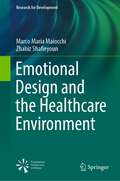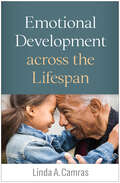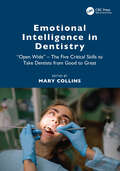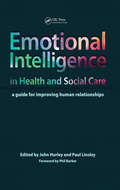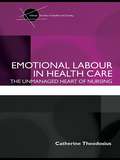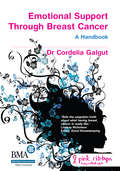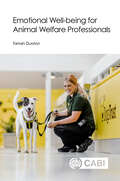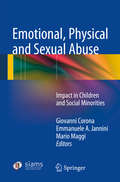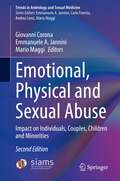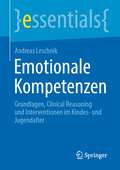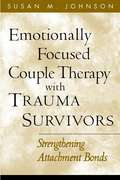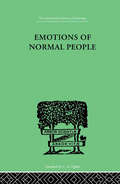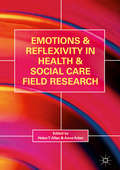- Table View
- List View
Emotional Bodies: The Historical Performativity of Emotions (The History of Emotions)
by Dolores Martín-Moruno Beatriz PichelWhat do emotions actually do? Recent work in the history of emotions and its intersections with cultural studies and new materialism has produced groundbreaking revelations around this fundamental question. In Emotional Bodies, contributors pick up these threads of inquiry to propose a much-needed theoretical framework for further studying the materiality of emotions, with an emphasis on emotions' performative nature. Drawing on diverse sources and wide-ranging theoretical approaches, they illuminate how various persons and groups—patients, criminals, medieval religious communities, revolutionary crowds, and humanitarian agencies—perform emotional practices. A section devoted to medical history examines individual bodies while a section of social and political histories studies the emergence of collective bodies. Contributors: Jon Arrizabalaga, Rob Boddice, Leticia Fernández Fontecha, Emma Hutchison, Dolores Martín Moruno, Piroska Nagy, Beatriz Pichel, María Rosón, Pilar León Sanz, Bertrand Taithe, and Gian Marco Vidor.
Emotional Design and the Healthcare Environment (Research for Development)
by Marco Maria Maiocchi Zhabiz ShafieyounFor all of the tremendous advances in medicine and treatment the world has seen in the modern era, the human body’s ability to heal itself remains a (literally) vital and often overlooked facet of healthcare. Through the use of emotional design, aimed at transforming healthcare environments, such as waiting rooms, in such a way as to boost the emotional wellbeing of patients, and thus their general attitudes, including in regard to their own healing processes, medical institutions can improve outcomes for the people they treat while simultaneously lowering overall costs. Design, as an inherently transdisciplinary, problem-solving activity, is well-suited to this task. And when combined with a field of study such as neuroscience, which can literally map out the perceptions that lead to the experience of particular emotions, healthcare environments can be transformed into spaces (through such innovations as Kansei engineering) that then subsequently transform the people who rely on them the most, leading to more efficiency and less red ink.
Emotional Development across the Lifespan
by Linda A. CamrasUnique in its dual focus on emotion and lifespan development, this text weaves together theory, research, and practical clinical implications for fostering children's emotional well-being. The author examines how emotions are experienced, expressed, understood, and regulated from infancy through later adulthood, surveying both typical and atypical development. For each stage, chapters highlight the interrelated influences of temperament, neurobiology, and the social environment, and distinguish universal processes from those that vary across cultures. The book presents current knowledge about specific emotions, probes the causes and consequences of emotional maladjustment, and reviews evidence-based and promising interventions. Innovative methods, examples, and meta-analyses are described; key terms are defined within chapters and in an end-of-book glossary.
Emotional Healing For Cats
by Stefan Ball Judy HowardCats have their ups and downs, just like people. Emotional Healing for Cats tells you what to do on the down days, including how to:-help your cat adjust to change and deal with illness and anxiety-deal with behavioural problems-understand life from your cat's point of viewWith a full guide to selecting Bach Flower Remedies and advice on other complementary therapies that can contribute to your cat's emotional health, Emotional Healing for Cats is the definitive guide to a balanced life for all your feline friends.Stefan Ball and Judy Howard are world experts on Dr Bach and his work. They teach practitioner level courses at the Bach Centre in England and have written widely on flower remedies and the complementary approach to health.
Emotional Healing For Horses & Ponies
by Stefan Ball Judy Howard Heather SimpsonOver the last few years there has been a revolution in the way we think about horses. At last we have clear ideas about how horses see the world, and about how they feel about themselves and the things we ask them to do.This book helps us to put these insights to work.Emotional Healing for Horses and Ponies brings together the skills of expert horsewoman and animal behaviourist Heather Simpson and those of leading Bach flower remedy experts Stefan Ball and Judy Howard. Together they describe how complementary medicine and simple changes in handling and housing routines can immeasurably improve the lives of our horses. Anybody who has been inspired by the tales of horse whisperers will find in this book practical steps that we can all take to give our horses happier and more joyful lives.
Emotional Intelligence in Dentistry: “Open Wide” - The Five Critical Skills to Take Dentists from Good to Great
by Mary CollinsThis book is a comprehensive guide for dental professionals (from undergraduates to experienced practitioners) to understand and apply the core skills of Emotional Intelligence to enhance their personal and professional success. EQ relates to how an individual can understand and manage their own emotional needs as well as recognise and deal with the needs of others and the skills to do this. For dental professionals, these are important skills to have, as every interaction with a patient requires the ability to connect with them emotionally in a positive way. Research shows us that those who can put their EQ skills into practice are more successful and happier in life.The book is pragmatic in nature, drawing on real-life case studies from dentists in the field. This book looks at the application of the most up-to-date research on EQ that will make a direct impact on the practice of dentistry.
Emotional Intelligence in Health and Social Care: A Guide for Improving Human Relationships
by Paul Linsley John Hurley'While emphasising caring for others, this book also place great importance on the practitioner caring for and developing themselves. Contemporary care environments place high demands upon students and practitioners of all disciplines. We want practitioners to do more than simply survive these environments, we want practitioners to thrive and feel enabled to lead themselves and others.' John Hurley and Paul Linsley, in the Preface Emotional intelligence is centred in self-awareness, empathy and leadership, as well as communication, relatedness and personal resilience. This book adopts a fresh approach to personal and professional development in healthcare by applying emotional intelligence to a range of clinical and educational contexts..This practical, user-friendly guide engages the reader on both an emotional and a cognitive level, offering an energising way for healthcare professionals to work more effectively as individuals and as part of a team. The activities provided are thought-provoking for personal study and ideal for session planning in larger groups. Emotional Intelligence in Health and Social Care is recommended for all educators and students of medicine, nursing, social care and the Allied Health Professions. When I began my professional training over forty years ago the curriculum paid no attention to the 'stuff' of the 'emotions'. However, when faced with the confusion of real people, and the uncertainty of decision making, I - like everyone else - had to draw on my emotions; feeling my way towards a different kind of knowledge. A book like this might have helped me come to a different understanding of what I needed to do to help myself to coexist with, work alongside and help others. From the Foreword by Phil Barker
Emotional Labor in Work with Patients and Clients: Effects and Recommendations for Recovery (Occupational Safety, Health, and Ergonomics)
by Dorota Żołnierczyk-ZredaThis book describes psychosocial working conditions that negatively impact the mental and physical well-being of employees of various “assistance-related” professional groups, as well as individuals whose work is related to contact with demanding clients. It offers concepts and research on the causes and effects of emotional burden (most often manifested as stress and burnout) when working with patients, children, and clients. The book provides a detailed analysis of various aspects of emotional burden at work. It includes a description of studies carried out in 5 different professional groups that were exposed to emotional burden during emotional work and emotional labour. The book discusses the application of known and international diagnostic methods and provides an intercultural comparison. The current diagnosis of stress and burnout, as well as physical and mental health of individuals performing emotional work will be covered, as well as offering practical solutions on assistance for individuals based on the diagnosis of their health. This book is for any professional or aspiring professional in the field, including postgraduate students. Scientists and practitioners in the field of work and health psychology, management, occupational health and safety, and HR will find this book of interest. Employers of assistance and services sectors, authorities formulating employment laws, lawyers, and occupational medicine physicians are also among this book’s top audience.
Emotional Labour in Health Care: The unmanaged heart of nursing (Critical Studies in Health and Society)
by Catherine TheodosiusDo nurses still care? In today’s inflexible, fast-paced and more accountable workplace where biomedical and clinical models dominate health care practice, is there room for emotional labour? Based on original empirical research, this book delves into personal accounts of nurses' emotion expressions and experiences as they emerge from everyday nursing practice, and illustrates how their emotional labour is adapting in response to a constantly changing work environment. The book begins by re-examining Arlie Hochschild’s sociological notion of emotional labour, and combines it with Margaret Archer’s understanding of emotion and the inner dialogue. In an exploration of the nature of emotional labour, its historical and political context, and providing original, but easily recognisable, typology, Catherine Theodosius emphasises that it is emotion – complex, messy and opaque – that drives emotional labour within health care. She suggests that rather than being marginalised, emotional labour in nursing is frequently found in places that are hidden or unrecognised. By understanding emotion itself, which is fundamentally interactive and communicative, she argues that emotional labour is intrinsically linked to personal and social identity. The suggestion is made that the nursing profession has a responsibility to include emotional labour within personal and professional development strategies to ensure the care needs of the vulnerable are met. This innovative volume will be of interest to nursing, health care and sociology students, researchers and professionals.
Emotional Reasoning: Insight into the Conscious Experience
by Eva DéliNeuroscience has made significant progress in understanding the brain, but the nature of consciousness remains elusive. At the same time, recent spectacular advancements in artificial intelligence promise the prospect of machines attaining human-like cognitive abilities. At the center of both systems is a fundamental dance of stimuli and response, requiring a profound comprehension of the physical environment. Thus, quantum mechanics and general relativity can be applied to the mysteries of human behavior, such as the difficulty of predicting, controlling, or retracing our thoughts. This landmark book explores the nature of consciousness through the lens of physics rather than neuroscience.Physics has been an explanatory force in diverse phenomena, and it can offer an entirely new vision of consciousness as an irreducible entity, similar to particles, the fundamental units of energy or matter. The fermionic mind hypothesis emerges as a tour-de-force synthesis and framework for understanding consciousness, reimagined as the elemental unit of intellect. It highlights particle organization, a fundamental structure that cannot be understood as the sum of its parts, as the essential analogy between fermions and consciousness.The book presents an engaging scientific narrative that explores some of humanity's oldest and most challenging questions. What is consciousness? What are emotions? How can a physical brain create subjective experience? Do we have free will? Engaging and penetrating, Emotional Reasoning represents a groundbreaking perspective that will surprise you at every turn. It will enhance your confidence through understanding yourself and your place in the cosmic order. Beyond neuroscience, the book holds profound implications for artificial intelligence research. It reveals the intricate link between consciousness and the physical universe, echoing the philosophical insight of theoretical physicist John Wheeler: "The physical world is, in some deep sense, tied to the human being."
Emotional Schema Therapy
by Robert L. LeahyOver decades of practice of cognitive-behavioral therapy (CBT), Robert L. Leahy has made important discoveries about the role that beliefs and expectations about emotions play in psychopathology. This book presents innovative tools for helping patients to understand their emotional schemas--such as the conviction that painful feelings are unbearable, shameful, or will last indefinitely--and develop new ways of accepting and coping with affective experience. Therapists can integrate emotional schema therapy into the treatment approaches they already use to add a vital new dimension to their work. Rich case material illustrates applications for a wide range of clinical problems; assessment guidelines and sample worksheets and forms further enhance the book's utility.
Emotional Support Through Breast Cancer
by Cordelia GalgutThis compassionate guide presents an array of new perspectives on the emotional effects of breast cancer and includes many personal testimonies from women who have been diagnosed with this disease. Written by a breast cancer survivor and practising psychologist, it shares practical ideas to help support sufferers at all stages, be it at diagnosis, during treatment or during life after the initial treatments are over. The concise, easy-to-read format includes exercises to develop an acceptance of thoughts and feelings, whilst the individual accounts validate the multitude of emotions felt by sufferers. It is a must for all breast cancer patients and sufferers, their families and friends. Its real-life approach, using first hand accounts, is also highly recommended for all health and social care professionals wanting a fresh approach to managing the emotional impacts of breast cancer. The shock of being diagnosed with breast cancer is hard to describe in words, as anyone who has had to suffer this diagnosis knows. Until it happens to us, we cannot really know how it feels. Not only do we have to deal with the diagnosis and subsequent treatments, but also we have to deal with the fact that breast cancer profoundly affects how we feel about ourselves as women. From the Introduction
Emotional Survival Guide for Caregivers
by Barry Jacobs Steven ZaritCaring for a parent whose health is in decline turns the world upside down. The emotional fallout can be devastating, but it doesn't have to be that way. Empathic guidance from an expert who's been there can help. Through an account of two sisters and their ailing mother--interwoven with no-nonsense advice--The Emotional Survival Guide for Caregivers helps family members navigate tough decisions and make the most of their time together as they care for an aging parent. The author urges readers to be honest about the level of commitment they're able to make and emphasizes the need for clear communication within the family. While acknowledging their guilt, stress, and fatigue, he helps caregivers reaffirm emotional connections worn thin by the routine of daily care. This compassionate book will help families everywhere avoid burnout and preserve bonds during one of life's most difficult passages.
Emotional Well-being for Animal Welfare Professionals (CABI Concise)
by Dr Tamsin DurstonEach year, many thousands of animals are taken into rescue centres and animal shelters around the world. Some will have suffered neglect or cruelty, others relinquished because their owners are no longer able to cope with caring for a much-loved pet. Many owners will require support and guidance in meeting their animals' needs and helping them thrive in environments which can sometimes be challenging. Often animal welfare and veterinary staff are affected deeply by the decisions that they need to make on a daily basis and are at risk from a whole range of emotional health issues. This book examines the risks to the emotional well-being of animal welfare staff and veterinary professionals. It provides practical solutions, coping strategies and various techniques aimed at restoring a work-life balance as well as giving guidance on creating healthy approaches to self-care for the emotionally challenging work undertaken by anyone working directly with animals. There is: · Practical advice on recognising the risks such as compassion fatigue, burnout and imposter syndrome · Guidance on creating emotional resilience through healthy coping strategies · Down-to-earth advice on supporting front line team members and public-facing animal care teams · A range of case studies by experts that help give professionals the strength to make positive changes An invaluable and important text for veterinary professionals, animal rescue workers, pet behaviour counsellors and dog training instructors, as well as support, administrative and front-line animal care teams.
Emotional, Physical and Sexual Abuse
by Mario Maggi Giovanni Corona Emmanuele A. JanniniThis book describes different kinds of psychological, physical and sexual maltreatment and explains their possible consequences, especially as regards quality of life, psychopathology and sexual life. The focus is specifically on the victims of abuse, who are among the more frail and vulnerable members of society. The book examines the impacts of maltreatment of both children and social minorities, such as homosexuals and gender dysphoric individuals or those affected by disabilities and describes skills that are of value in supporting victims of maltreatment and preventing discrimination. The work will be useful to sexual medicine specialists, medical doctors, psychologists and psychiatrists, as well as graduate students in these disciplines. By fostering a better understanding of discrimination triggers and effects, it will help clinicians to provide improved support through the tailoring of therapies to the needs of maltreated individuals.
Emotional, Physical and Sexual Abuse: Impact on Individuals, Couples, Children and Minorities (Trends in Andrology and Sexual Medicine)
by Mario Maggi Giovanni Corona Emmanuele A. JanniniThis new edition aims to examine the impacts of maltreatment of both children and social minorities, such as homosexuals and gender dysphoric individuals or those affected by disabilities, in women, in patients, and describes skills that are of value in supporting victims of maltreatment and preventing discrimination. On this purpose, the new book is not only an update of the current literature on the topic, but will be also enriched by chapters dealing with the subtle border between courtship and harassment, with the responsibilities of the health professionals, with the role of internet and pornography in the “economy” of abuses and sexual slavery, with forensic aspects of the abuses and with therapy of both suffered and operated sexual violence starting from prevention as social education until medical approaches. This new edition will be particularly useful to sexual medicine specialists, medical doctors, psychologists and psychiatrists, as well as graduate students in these disciplines, but also to sociologists, educators and law professionals. By fostering a better understanding of discrimination triggers and effects, this new edition will help clinicians and mentors to provide improved support through the tailoring of therapies to the needs of maltreated and abused individuals.
Emotionale Intelligenz bei Kindern fördern: Ein Elternratgeber mit interaktiven Geschichten, Übungen und Spielen
by Irina Bosley Erich KastenSoziale und emotionale Kompetenzen beeinflussen unsere Fähigkeiten, Emotionen bei sich und anderen richtig einzuschätzen und regulieren zu können, positive Ziele zu setzen und zu erreichen, Empathie für andere zu zeigen, Beziehungen aufzubauen und aufrechtzuerhalten sowie verantwortungsvolle Entscheidungen zu treffen. Neben den kognitiven Fähigkeiten verhelfen sie nicht nur in der Schule, sondern in allen Lebensbereichen zum Erfolg. Aus diesem Grund ist es gerade bei Kindern wichtig, eine gesunde Entwicklung im Umgang mit ihren Gefühlen sowie ihren zwischenmenschlichen Beziehungen zu fördern.In diesem Elternratgeber werden die psychologischen Grundlagen sowie die Bedeutung der emotionalen Intelligenz kompakt und anschaulich anhand von Beispielen erklärt. Im Fokus stehen fünf Kompetenzgruppen des Sozial-Emotionalen Lernens (SEL) bei Kindern: Selbstwahrnehmung, soziales Bewusstsein, Selbstmanagement, verantwortungsvolle Entscheidungen und Beziehungsmanagement. In einem zweiten, ausführlichen Übungsteil mit zahlreichen kindgerechten Illustrationen zeigen die Autoren, wie Sie als Eltern die emotionalen Kompetenzen Ihrer Kinder mit interaktiven Geschichten, vielfältigen Übungsaufgaben und Spielen im Alltag fördern können.
Emotionale Kompetenzen: Grundlagen, Clinical Reasoning und Interventionen im Kindes- und Jugendalter (essentials)
by Andreas LeschnikIn diesem essential werden die wissenschaftlichen Grundlagen von Emotionen erklärt. Außerdem gibt es einen kurzen Überblick über die kindliche Entwicklung von emotionalem Verhalten. Zudem werden Faktoren aufgezählt, die die Emotionalität beeinflussen können. Im weiteren Verlauf wird das hypothetisch-deduktive Clinical Reasoning zum Erstellen einer therapeutischen Diagnose bei Kindern und Jugendlichen mit Störungen der Emotionalität eingesetzt. Am Ende bietet dieses essential Interventionsmöglichkeiten für Kinder und Jugendliche, um das emotionale Verhalten zu verbessern.
Emotionale Regulation bei psychischen Störungen: Praxis der Verhaltenstherapie schematherapeutisch erweitert (Psychotherapie: Praxis)
by Claudia Stromberg Kristin ZickenheinerDieses Buch zeigt Psychotherapeutinnen und -therapeuten, wie störungsspezifische Verhaltenstherapie durch transdiagnostisch wirksame Prozesse der Schematherapie angereichert werden kann. Besonders bei Behandelten mit niedrigem Funktionsniveau und schwierigen Therapieverläufen ist dieser duale Fokus entscheidend für einen nachhaltigen Behandlungserfolg. Im konzeptuellen Teil I wird der Erweiterungsbedarf u. a. entlang der Neuerungen von DSM-5 und ICD-11 und neurowissenschaftlicher Perspektiven beleuchtet und ein grundlegendes Konzept der Verzahnung von SORKC-Modell und schematherapeutischem Modusmodell entwickelt. Im praxisorientierten Teil II stellen wir die schematherapeutisch erweiterten Störungsmodelle und Behandlungspläne für ausgesuchte Störungen dar. Mit einem Geleitwort von Prof. Dr. Ulrich Schweiger. Aus dem Inhalt: Praxisorientierte Leitfäden zur Indikationsstellung und Prozesssteuerung – detaillierte Veranschaulichung der Modelle und Techniken – ausführliche Anleitung für Depression, Soziale Angststörung, GAS, Zwangsstörung, PTBS. Die Autorinnen: Dr. Claudia Stromberg, Psychologische Psychotherapeutin, Verhaltens- und Schematherapie. Dozentin und Supervisorin in Aus- und Fortbildung, Institutsleitung GAP Frankfurt, Co-Trainings-Director IST-F, Vorstandsmitglied des DVT. Dr. Kristin Zickenheiner, Psychologische Psychotherapeutin, Verhaltens- und Schematherapie. Dozentin und Supervisorin in Aus- und Fortbildung, tätig in eigener Praxis, ehem. Vorstandsmitglied ISST.
Emotionally Disturbed: A History of Caring for America's Troubled Children
by Deborah Blythe DoroshowBefore the 1940s, children in the United States with severe emotional difficulties would have had few options for care. The first option was usually a child guidance clinic within the community, but they might also have been placed in a state mental hospital or asylum, an institution for the so-called feebleminded, or a training school for delinquent children. Starting in the 1930s, however, more specialized institutions began to open all over the country. Staff members at these residential treatment centers shared a commitment to helping children who could not be managed at home. They adopted an integrated approach to treatment, employing talk therapy, schooling, and other activities in the context of a therapeutic environment. Emotionally Disturbed is the first work to examine not only the history of residential treatment but also the history of seriously mentally ill children in the United States. As residential treatment centers emerged as new spaces with a fresh therapeutic perspective, a new kind of person became visible—the emotionally disturbed child. Residential treatment centers and the people who worked there built physical and conceptual structures that identified a population of children who were alike in distinctive ways. Emotional disturbance became a diagnosis, a policy problem, and a statement about the troubled state of postwar society. But in the late twentieth century, Americans went from pouring private and public funds into the care of troubled children to abandoning them almost completely. Charting the decline of residential treatment centers in favor of domestic care–based models in the 1980s and 1990s, this history is a must-read for those wishing to understand how our current child mental health system came to be.
Emotionally Focused Couple Therapy with Trauma Survivors
by Susan M JohnsonThis book provides a theoretical framework and an innovative model of intervention for distressed couples whose relationships are affected by the echoes of trauma. Combining attachment theory, trauma research, and emotionally focused therapeutic techniques, Susan M. Johnson guides the clinician in modifying the interactional patterns that maintain traumatic stress and fostering positive, healing relationships among survivors and their partners. In-depth case material brings to life the process of assessment and treatment with couples coping with the impact of different kinds of trauma, including childhood abuse, serious illness, and combat experiences. The concluding chapter features valuable advice on therapist self-care.
Emotions Of Normal People (International Library Of Psychology Ser.)
by Marston, William MoultonFirst published in 1999. Routledge is an imprint of Taylor & Francis, an informa company.
Emotions and Reflexivity in Health & Social Care Field Research
by Helen T. Allan Anne ArberThis book is about emotions and reflexivity when doing field research in health and social care settings. Health and social care students often undertake field research in their own area of practice using observation and interviews. All contributing authors have a dual identity as researchers and health or social care professionals. Their chapters draw on research carried out in a number of fields including HIV related infertility and adoption, primary care in Africa, cancer and palliative care, infertility and excluded young people to explore issues relevant to emotions and reflexivity from the perspective of the researcher and research participants. The book was born of the two editors, who are experienced research supervisors, observing that many PhD students struggle to manage the emotions elicited in the field when researching. They identify three main causes - health and social care deals with painful topics; observation and interviews bring student into contact with powerful feelings which need processing; there is very little advice and discussion of how a PhD student manages emotions in the field and students therefore frequently struggle on their own. This insightful volume will be of great interest to scholars and students in all areas of academic study, but particularly to those who chose to study health and social care whether they are professionals or not.
Emotions and Surgery in Britain, 1793–1912
by Michael BrownIn this innovative analytical account of the place of emotion and embodiment in nineteenth-century British surgery, Michael Brown examines the changing emotional dynamics of surgical culture for both surgeons and patients from the pre-anaesthetic era through the introduction of anaesthesia and antisepsis techniques. Drawing on diverse archival and published sources, Brown explores how an emotional regime of Romantic sensibility, in which emotions played a central role in the practice and experience of surgery, was superseded by one of scientific modernity, in which the emotions of both patient and practitioner were increasingly marginalised. Demonstrating that the cultures of contemporary surgery and the emotional identities of its practitioners have their origins in the cultural and conceptual upheavals of the later nineteenth century, this book challenges us to question our perception of the pre-anaesthetic period as an era of bloody brutality and casual cruelty. This title is also available as open access.
Emotions and the Making of Psychiatric Reform in Britain, c. 1770-1820 (Palgrave Studies in the History of Emotions)
by Mark NeuendorfThis book explores the ways which people navigated the emotions provoked by the mad in Britain across the long eighteenth century. Building upon recent advances in the historical study of emotions, it plots the evolution of attitudes towards insanity, and considers how shifting emotional norms influenced the development of a ‘humanitarian’ temperament, which drove the earliest movements for psychiatric reform in England and Scotland. Reacting to a ‘culture of sensibility’, which encouraged tears at the sight of tender suffering, early asylum reformers chose instead to express their humanity through unflinching resolve, charging into madhouses to contemplate scenes of misery usually hidden from public view, and confronting the authorities that enabled neglect to flourish. This intervention required careful emotional management, which is documented comprehensively here for the first time. Drawing upon a wide array of medical and literary sources, this book provides invaluable insights into pre-modern attitudes towards insanity.

